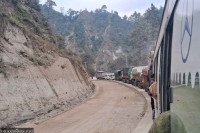Opinion
Power of the adolescent girl
Girls’ personal and collective growth can contribute to solving the emerging global problems
Christian Manhart
What would you like the world to look like in 2030? End poverty, ensure prosperity for all and protect the planet. This is what representatives of 193 nations agreed on with the newly adopted Sustainable Development Goals for 2030, which build on the Millennium Development Goals achieved by the member states of the United Nations over the past 15 years.
Insufficient investment
Now more than ever, efforts are required to encourage adolescent girls to change the world. Girls are our future. Highlighting the importance of investing in adolescent girls’ empowerment and supporting their rights, this year’s theme for the International Day of the Girl Child is ‘The Power of the Adolescent Girl: Vision for 2030’.
Over the last 15 years, the global community has made a significant progress in advancing the lives of girls during early childhood. According to the Education-For-All Global Monitoring Report 2015, there are 84 million fewer out-of-school children and adolescents of which 52 million are girls. Similarly, today, girls in the first decade of life are more likely to enrol in primary school, receive key vaccinations, and are less likely to suffer from health and nutrition problems compared to previous generations. However, challenges persist. As we reflect on the achievements of the past decades, we must also admit that there has been insufficient investment and improvement in addressing the issues girls face when they reach adolescence. The major challenges, inter alia, are obtaining quality secondary and higher education, avoiding child marriage, countering gender-based violence and becoming well informed about sexual and reproductive health.
Adolescent girls
Adolescence, that period in life after childhood and right before adulthood (ages 10 to19), is a delicate transition phase. It is a double-edged sword with incredible opportunities but also considerable risks. Multi-dimensional changes occur in the lives of human beings during this period. These alterations are inter-linked and affect the overall development of humans. Such changes are more diverse and critical in the case of girls than boys.
If appropriate support is provided, girls have the potential to change the world. We must build a more suitable place for today’s and tomorrow’s workers, mothers, mentors and leaders in different disciplines. Girls’ personal and collective growth can contribute to solving the emerging global problems of climate change, political conflict, economic growth, disease prevention, and global sustainability.
The Census Report 2011 reveals that adolescent girls account for 23.45 percent of the female population of Nepal—they are about one-fourth of the total number of women. Furthermore, the Nepal Living Standards Survey (2010/2011) shows that nearly 84.2 percent adolescent girls are literate. However, there is a need for improvement in many areas to turn their potential into reality. Early marriage, parents’ educational investment in boys rather than in girls, gender-based violence and the lack of care during menstruation is still prevalent in Nepali society. Girls also get married earlier than boys. The Nepal Health and Demographic Survey (2011) shows that among women aged 20-49, 52 percent were married by the age of 18 and 16 percent were already married by the age of 15.
Come together
Nepal faced a severe natural disaster this year resulting in multi-dimensional impacts on the lives of people and more specifically on children and adolescents.The Post Disaster Risk Assessment (PDNA) issued by the National Planning Commission in June highlights that the adolescent girls living in earthquake-hit areas face heightened risks of sexual and gender-based violence, human trafficking, child marriage, and child labour.
As Nepal recovers from the devastating earthquake, it is in this crucial moment that we must join forces to ensure and fast-track the process of recognising the needs of adolescent girls and promoting their holistic powers. It will be instrumental in forging efficient and empowered leaders in the future, thus contributing directly to building a better nation.
The time has come to counter the challenges, which have been left unaddressed during the MDG era. The post-2015 vision should be more constructive, collaborative and result-oriented.
Manhart is the Head of Unesco Office in Kathmandu




 16.66°C Kathmandu
16.66°C Kathmandu












